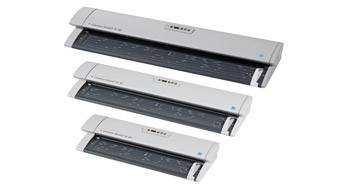If you have been browsing our selection of Colortrac large format scanners, you may have wondered why you necessarily need to invest in such a scanner at all. After all, a digital camera is similarly capable of producing image files from two-dimensional originals for subsequent viewing on a computer.
With cameras also being a lot cheaper than large format scanners, it may seem a foregone conclusion that they are the superior option. However, there are also a number of key differences between the two to take into account.
1. Lighting A Large Format Scanner can produce perfectly contrasted images without the need for special lighting conditions or to be set up in a particular way. When you use a scanner, the image is lit very close to the original for perfectly exposed results and minimal image disturbance from folds or creases.
2. Speed A large format scanner is also capable of processing a single A0 document every 12 seconds at 600dpi, compared to the many minutes of preparation that digital cameras typically require.
3. Mounting Using a digital camera to capture a two-dimensional original requires you to lay the original flat, hang it on the wall or keep it flat on the glass if you are to perfectly capture it.
4. Accuracy The calibration of a large format scanner to provide length accuracy to within 0.1% and line quality to within a pixel enables large format scans to be used for direct estimation work, using the original drawing’s scale.
5. Substrate flexibility Another great benefit of using a large format scanner is its ability to easily process opaque, high gloss and transparent originals – even those mounted on card or board.
6. Resolution While even the images from high-quality digital cameras can have a resolution as low as 150dpi or less when used for an A0 original, a large format scanner is capable of producing crystal sharp images at up to 600dpi.
7. Distortion You don’t have to worry about your images suffering from lens barrel distortion and warping when they are produced by a large format scanner, whereas camera lens distortion often has to be corrected by those with Photoshop software and expertise in how to use it.
8. Quality control With a large format scanner, 1:1 viewing of your scanned images is possible seconds after the document has been scanned. You can opt for lossless or lossy compression through the scanning software.
9. Colour control Depending on your specific requirements, you can use a large format scanner to produce colour images in sRGB, Adobe RGB or machine colour spaces. Such colour management benefits can extend to your colour printer if you use the scanner to copy or produce physical hard copies.
Trust Prizma Graphics as your source of wide format scanners from Colortrac that enable you to gain the best results from your projects this season. Remember that if you would like to discuss your specific requirements with us, you can call us via 01296 393700.


